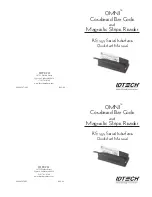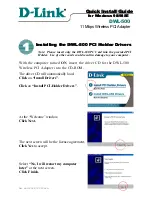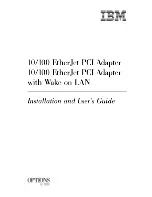
8
8
5
5
TROUBLESHOOTING
The Omni reader is easy to install and use. Most problems encountered can
be attributed to:
•
Incorrect Interface Cabling
•
Incorrect Configuration Setup
•
Bad Magnetic Stripe or Bar Code Quality
•
Application RS-232 Parameter Setting Error
GENERAL PROCEDURES
The troubleshooting process can be simplified by following these simple
diagnostic procedures.
1. The unit should emit two beeps when power is first applied. If it does not,
then the unit is not receiving power.
2. Once it has been confirmed that the unit is correctly powered, try swiping
a credit card. The LED will glow amber to indicate a “good read,” or red to
indicate a “bad read.”
3. Once the unit has indicated a “good read,” then proceed to check the inter-
face cabling connections.
4. Check the RS-232 parameter setting.
DEFAULT SETTINGS TABLE
The Omni reader is shipped from the factory with the following bar code default
settings already programmed:
TROUBLESHOOTING
The Omni reader is easy to install and use. Most problems encountered can
be attributed to:
•
Incorrect Interface Cabling
•
Incorrect Configuration Setup
•
Bad Magnetic Stripe or Bar Code Quality
•
Application RS-232 Parameter Setting Error
GENERAL PROCEDURES
The troubleshooting process can be simplified by following these simple
diagnostic procedures.
1. The unit should emit two beeps when power is first applied. If it does not,
then the unit is not receiving power.
2. Once it has been confirmed that the unit is correctly powered, try swiping
a credit card. The LED will glow amber to indicate a “good read,” or red to
indicate a “bad read.”
3. Once the unit has indicated a “good read,” then proceed to check the inter-
face cabling connections.
4. Check the RS-232 parameter setting.
DEFAULT SETTINGS TABLE
The Omni reader is shipped from the factory with the following bar code default
settings already programmed:
HOST CONNECTIONS
The reader is connected to the host’s RS-232 communications port. The cable
has a DB-9 connector at one end, and is connected to the reader at the other
end. (An adapter can be used to connect to a DB-25 RS-232 port.)
Data is transmitted to the host in an ASCII data format. The reader’s output
can be formatted with terminating characters and special preamble and/or
postamble character strings to match the data format expected by the termi-
nal.
The terminal must be configured to accept the data and to perform the appro-
priate processing. Care must be taken to ensure that the RS-232 parameters
(baud rate, data bits, Start/Stop characters, parity, and handshaking method)
match those expected by the terminal. Just transmitting the data to the serial
port does not necessarily mean it will appear on the screen as if it were
entered manually.
If the host is programmable (such as a PC running in terminal mode), a
communication program, such as Procomm or Hyperterminal, can be used to
display the data. In this way, data from the serial port appears to the host as if
it has been entered manually via the keyboard.
There is insufficient power available on a standard RS-232 serial port to
power the reader, so an external wall-mounted power module must be used.
Connect the power cable from this unit to the power receptacle located on
the DB-9 connector. Care must be taken to ensure the power module operates
5 VDC +10%.
HOST CONNECTIONS
The reader is connected to the host’s RS-232 communications port. The cable
has a DB-9 connector at one end, and is connected to the reader at the other
end. (An adapter can be used to connect to a DB-25 RS-232 port.)
Data is transmitted to the host in an ASCII data format. The reader’s output
can be formatted with terminating characters and special preamble and/or
postamble character strings to match the data format expected by the termi-
nal.
The terminal must be configured to accept the data and to perform the appro-
priate processing. Care must be taken to ensure that the RS-232 parameters
(baud rate, data bits, Start/Stop characters, parity, and handshaking method)
match those expected by the terminal. Just transmitting the data to the serial
port does not necessarily mean it will appear on the screen as if it were
entered manually.
If the host is programmable (such as a PC running in terminal mode), a
communication program, such as Procomm or Hyperterminal, can be used to
display the data. In this way, data from the serial port appears to the host as if
it has been entered manually via the keyboard.
There is insufficient power available on a standard RS-232 serial port to
power the reader, so an external wall-mounted power module must be used.
Connect the power cable from this unit to the power receptacle located on
the DB-9 connector. Care must be taken to ensure the power module operates
5 VDC +10%.


























